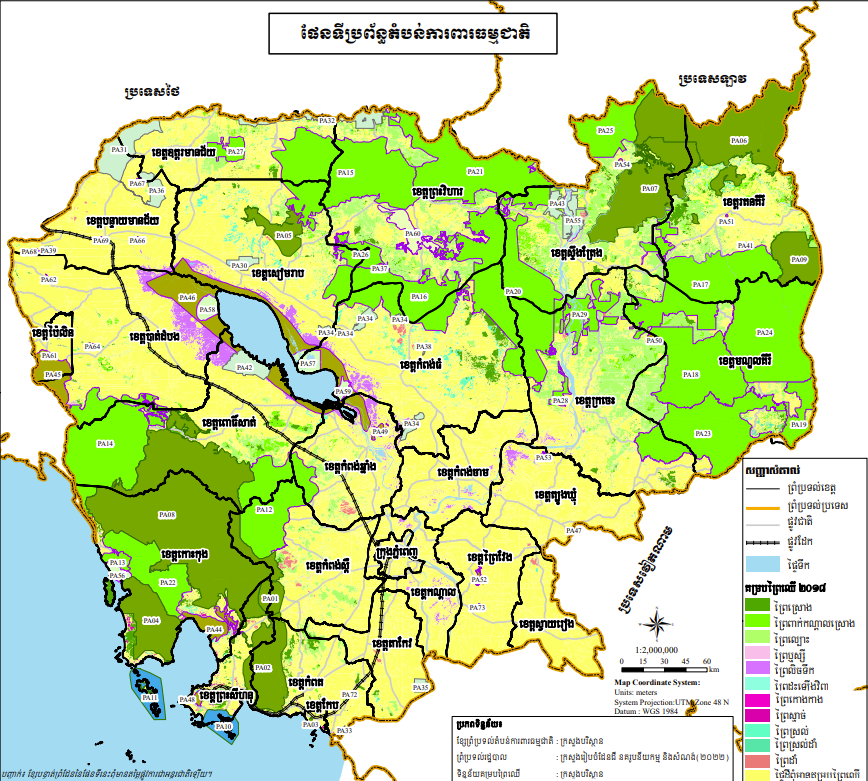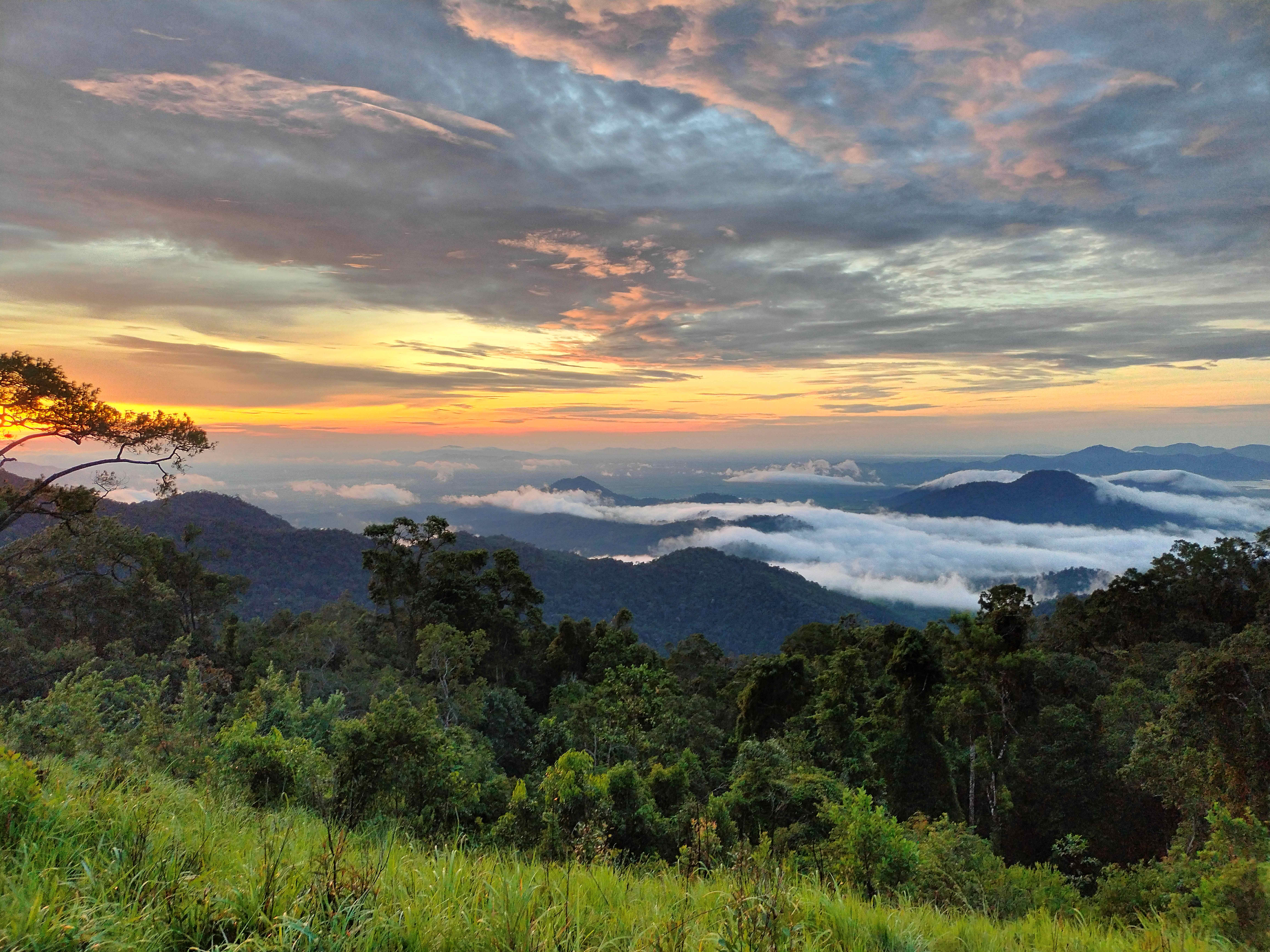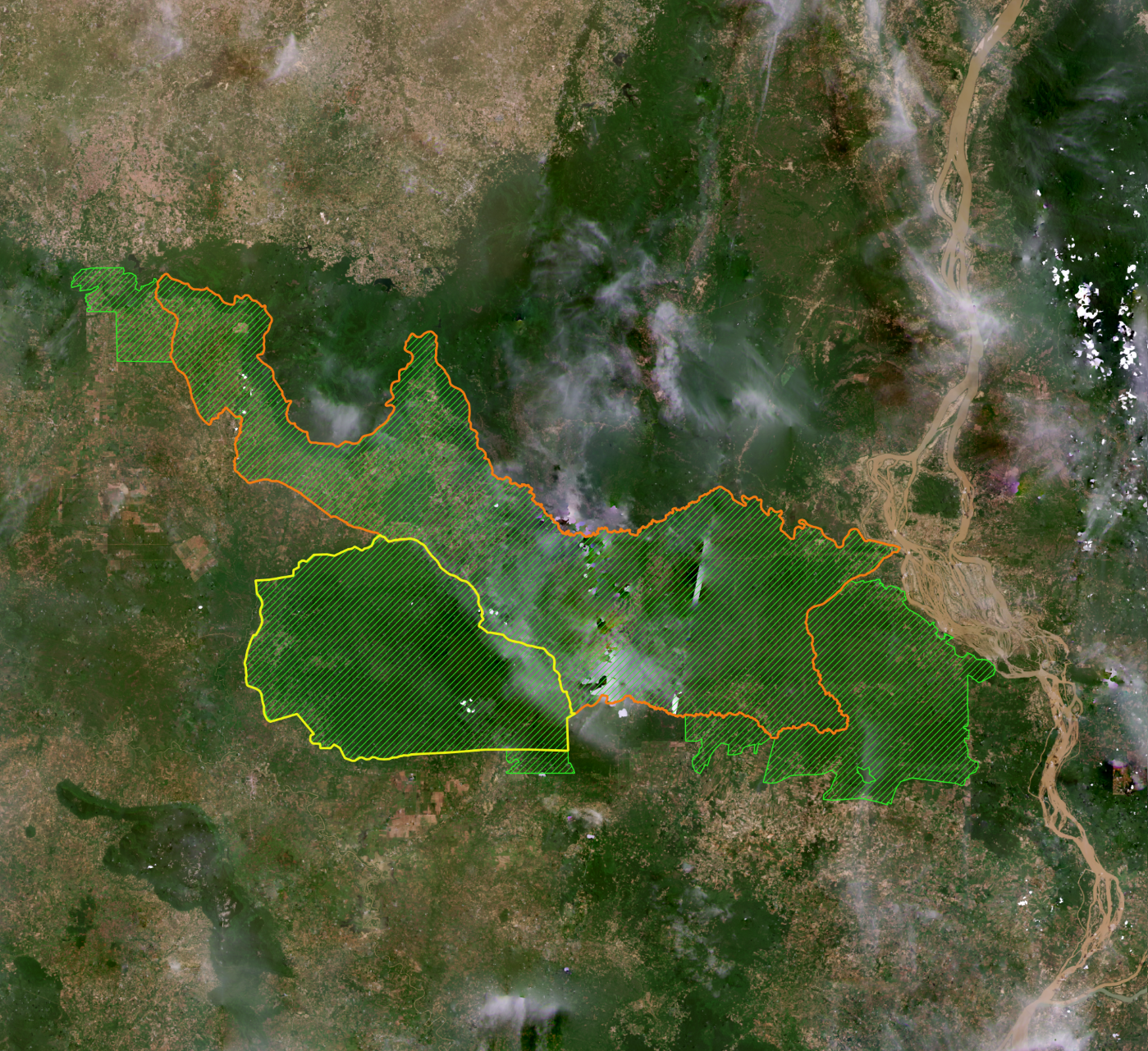- Cambodia expanded the coverage of its protected areas by 1.06 million hectares (2.62 million acres) in July and August, a flurry of subdecrees shows.
- However, civil society groups have expressed skepticism about the lack of consultation involved in the process and the ability of authorities to police this much larger area, given the ineffective enforcement of existing protected areas.
- Much of the newly protected land appears to be corridors neighboring existing protected areas, where homes and farms are already established.
- This has raised concerns about a surge in conflicts over land and access to natural resources, particularly affecting Indigenous communities.
PHNOM PENH, Cambodia — A flurry of subdecrees released through the end of July and early August show that the Cambodian government has approved he addition of more than a million hectares of land, or 2.5 million acres, to the country’s protected areas.
But amid the ongoing deforestation and privatization of Cambodia’s protected areas, civil society groups and activists remained skeptical given the lack of consultation involved in the process.
In what appears to be a comprehensive review of Cambodia’s protected-area system, more than 40 subdecrees amending protected areas across the country were issued between July and August, with 1.06 million hectares (2.62 million acres) added to the protected areas system and 34,395 hectares (84,992 acres) degazetted from four existing protected areas.
“Currently we are reviewing all land use throughout Cambodia and there are certain types of place where the soil composition is not suitable for agriculture, so that’s where we can turn that land back to conservation land,” then-environment minister Say Samal told Mongabay in a text message shortly before a post-election cabinet reshuffle that saw him take office as minister of land management. “We’re going through it every day now, with all the limited resources and expertise that we have.”
Much of the newly protected land has seen national parks and wildlife sanctuaries absorbing nearby biodiversity corridors. The corridors, which collectively span 1.43 million hectares (3.53 million acres) nationwide, were established by a 2017 subdecree, but were never formally granted protected status.
Many parts of these corridors are occupied by communities and have been severely degraded, often as a result of the emergence of concessions awarded by the government inside the biodiversity corridors.
Beyond the biodiversity corridors, the slew of new subdecrees also appears to be affecting the vaguely defined and little-understood multiple-use zones, as well as Ramsar sites — wetlands that are supposed to be protected by Cambodia’s accession to the Ramsar Convention in 1999 — which have also not been formally protected by the existing system, having no zonation or management plans in place beyond protection conferred by the international convention.

A chaotic introduction to big changes
The rollout of amendments was chaotic, inconsistent and often with only partial data published in relation to the new boundaries. No single source of information published all of the government documents. Instead, the information trickled out, one subdecree at a time, across a range of platforms, including government mouthpiece Fresh News, Samal’s Facebook account, the Facebook accounts of the Ministry of Information and that of Hun Manet, who took office as Cambodia’s new prime minister on Aug. 22.
Many of the subdecrees have pages missing, and all of the maps produced as part of the subdecrees appear to be missing data points, confounding conservationists attempting to understand the implications of the new protected areas.
The confusion continued when official documents produced by the Ministry of Environment in mid-August and seen by Mongabay stated that Cambodia now has 73 protected areas spanning 7.05 million hectares (17.41 million acres).

This means that the total area of Cambodia’s officially protected land is now slightly less than the roughly 7.3 million hectares (18 million acres) reported as protected by a 2018 Ministry of Environment assessment, in spite of the recent addition of more than 1 million hectares of protected land.
The government appears to have counted the 1.43 million hectares of biodiversity corridors in the 2018 figure for protected areas, despite the fact that the biodiversity corridors were not formally protected at the time, which could account for the discrepancy.
Samal has also republished subdecrees from previous years for at least 28 existing national parks, wildlife sanctuaries, marine parks and natural heritage parks, suggesting there will be no change to these protected areas, but that they will now become part of the formal protected area system under the Ministry of Environment’s jurisdiction.
Pablo Sinovas, country director at Fauna & Flora Cambodia, said his team had not been informed of the scope of the changes being introduced to Cambodia’s protected areas, echoing concerns voiced by other conservationists who were likewise unaware of the ministry’s plans. Sinovas said data on the new boundaries had not yet been shared by the ministry, adding that Fauna & Flora had only received the figures for the changes, rather than the maps and associated geospatial data needed to understand the changes in full.
“There are two sides to this: Cambodia’s had a lot of protected land, roughly 41% [of its landmass] — more than most countries and well over the 30% global target,” Sinovas said. “So even though the overall area has decreased slightly to around 39%, it’s still well over the 30% target — the key will be to ensure effective management.”
The absorption of biodiversity corridors into the formal protected area system offers a chance for restoration, Sinovas said, noting that much of the newly protected land is already quite degraded.
“Some valuable pieces of forest have been degazetted, while some degraded parts have been protected, so clearly it’s a balancing act trying to keep those protected figures up,” he said. “But realistically, the overall coverage of protected areas in Cambodia is quite high, so an overall reduction is not a terrible thing.”
Sinovas said Fauna & Flora Cambodia remained ready to support the Ministry of Environment to ensure newly protected areas are managed effectively, the highest-value conservation areas are prioritized, and the needs of the communities are met.
Alistair Mould, country director of the Wildlife Conservation Society (WCS) Cambodia, said his NGO is also committed to collaborating with the Ministry of Environment’s new administration and local communities to enhance protected zoning and community involvement in protected area management.
“The growth of Cambodia’s protected area network calls for increased resource allocation to support effective protected area management and community-centered land-use planning,” he said.

At-risk protected areas expand
Notable areas that changed under the new subdecrees include Central Cardamoms National Park (where Mongabay investigations uncovered illegal logging linked to a network of timber traders operating from the Koh Kong provincial prison and to Cambodia’s garment sector). This was merged with Southern Cardamoms National Park (where carbon credit certifier Verra recently launched an investigation into alleged human rights abuses in the Southern Cardamoms REDD+ project).
The two parks became one, known as Cardamoms National Park, and also absorbed an additional 115,542 hectares (285,511 acres) in the process. Samal didn’t directly address questions as to why the newly formed national park had grown so considerably or where the additional land came from.
The Wildlife Alliance, an NGO that works with the Ministry of Environment to co-manage the Southern Cardamoms REDD+ that Verra is investigating, declined to comment on the matter when reached by email.
Similarly, Veun Sai-Siem Pang National Park’s total area expanded almost fivefold, from 57,469 hectares to 280,359 hectares (142,009 acres to 692,782 acres) as it engulfed much of a formerly unnamed biodiversity corridor. That development also conferred protected status on land that was, in 2022, granted to a senior prisons department official at the Ministry of Interior who has since extensively logged previously untouched forested land in and around the concession.

The hotly contested Prey Lang Wildlife Sanctuary, where illegal logging has been rife for years, also gained 57,980 hectares (143,272 acres), mostly absorbing already degraded land around the protected area’s boundaries. Just north of Prey Lang, the protected area of Preah Roka was merged with Chaeb Wildlife Sanctuary, adding another 67,264 hectares (166,213 acres) to yet another beleaguered protected forest that has been the target of illegal loggers for many years.
A similar situation played out in Beng Per Wildlife Sanctuary, where despite more than a quarter of the sanctuary having been handed over to rubber barons, the Ministry of Environment added 23,333 hectares (57,657 acres) to the beleaguered protected area.

Overstretched and underfunded
These expansions are just a handful of examples that so far collectively expand Cambodia’s protected areas by more than 1 million hectares. But even before this reassessment of the protected-area system, the Ministry of Environment lacked the resources to protect all the land it was responsible for. Neth Pheaktra, then the environment ministry’s spokesperson, told Mongabay in 2022 that the ministry employs 1,200 rangers, meaning that each ranger would be responsible for patrolling and protecting 6,000 hectares (nearly 15,000 acres). Pheaktra was appointed minister of information in the August 2023 cabinet reshuffle.
Between 2016 and 2020, the Ministry of Environment spent just 0.5% and 0.6% of Cambodia’s national budget, despite managing more than 40% of the country’s land mass. For 2023, the Ministry of Environment received $35.5 million from the national budget, an 18.8% increase from the $29.8 million it received in 2022.
When asked how so much more land could be protected on a limited budget, Samal said “[We have] rangers plus combined armed forces and combined budgets of related ministries and provincial governments.”
Eang Sophalleth, who took office as Cambodia’s new environment minister on Aug. 22, did not immediately respond to questions sent by Mongabay.
But for those working in conservation and with communities who will likely be affected by the sweeping changes that are still being unleashed by the new subdecrees, there’s skepticism that the Ministry of Environment is getting the resources it needs.
Heng Kimhong, head of research and advocacy at the Cambodia Youth Network (CYN), has repeatedly led campaigns to encourage forest conservation in Cambodia and joined communities on patrol to protect forests, as well as to gather data on illegal logging in Prey Lang Wildlife Sanctuary and Preah Roka Wildlife Sanctuary.

“My personal perspective is that the Cambodian government should strengthen new mechanisms for the Ministry of Environment, increase [the number of] rangers and [increase] civic engagement to protect protected areas in Cambodia,” said Kimhong, who added that local communities, in particular Indigenous groups, should have more of a role in protecting natural resources, while corruption among rangers should be a priority to address.

But Kimhong also said the changes to the protected-area system could have “both positive and negative impacts,” noting that protected areas that have been reduced in this latest wave of changes are places that have seen high levels of deforestation associated with investments from allies of the ruling party.
Of the four protected areas that have been reduced, the biggest changes were seen in the beleaguered Botum Sakor National Park in the southwest province of Koh Kong, where economic land concessions have all but consumed the park. Botum Sakor’s area dropped from 171,250 hectares to 143,895 hectares (423,168 acres to 355,572 acres), having already been reduced in size from its original 182,342 hectares (450,577 acres). The latest changes largely appear to have removed protections from a 36,000-hectare (89,000-acre) concession held by the Chinese-run Union Development Group, while other concessions — including those of Cambodian conglomerate Royal Group and the politically connected Koh Kong Rubber — remain inside the updated national park.
Peam Krasop Wildlife Sanctuary, also in Koh Kong province, saw the next biggest loss of land, dropping from 23,750 hectares to 16,982 hectares (58,688 acres to 41,963 acres), with more than 6,700 hectares (16,600 acres) of mostly mangrove forests degazetted by the latest round of subdecrees. Much of the mangrove forests were then absorbed by Koh Kapik Ramsar Site, which was formally protected by the new subdecrees and expanded from 12,000 hectares to 14,029 hectares (29,652 acres to 34,666 acres).

Conflict over land already brewing in response
Kimhong warned that this year’s new amendments to protected areas, particularly the absorption of biodiversity corridors that sit between protected areas, could lead to more land disputes, particularly with Indigenous communities.
He referred to the case of the Sorsor Sdam Satv To Multiple Use Area, which expanded more than six times its original size, from 839 hectares to 5,327 hectares (2,073 acres to 13,163 acres), in Kratie province’s Srae Chis commune, close to the Vietnamese border in eastern Cambodia.
Srae Chis residents, most of whom belong to the Kraol Indigenous group, responded to news of the protected area’s expansion by burning down a Ministry of Environment ranger station in early August. The community complained that they’d received no consultation, no compensation for loss of agricultural land, and that the rangers posted at the station had been involved in corrupt acts that had furthered deforestation in their community forest.
Numerous other expansions of Cambodia’s protected areas also overlap with land occupied by communities and, in some cases, land that has been awarded to communities in the form of social land concessions or Indigenous community land titles.

“It’s deeply concerning that a significant amount of the land newly classified as ‘protected’ by the Ministry of Environment appears to already have homes and farmland on it,” said Naly Pilorge, director of outreach at local rights group LICADHO. “When hundreds of thousands of hectares are suddenly reclassified without properly consulting the people living there, it is a recipe for land and natural resource conflicts, particularly if those people have not yet received hard land titles.”
The sheer scale of the land reclassification is particularly worrying, she said, when looked at in the context of a fresh wave of economic land concessions being awarded, including those in both existing and newly created protected areas. In Koh Kong and Stung Treng provinces, new concessions have emerged in the past year, despite Cambodia’s 2012 moratorium on the issuance of new concessions.
But Samal maintained that the rezoning of Cambodia’s protected areas was designed to avoid conflicts over land and to ensure that boundaries between various forms of land were properly established.
“The initial step is to make sure that there are no conflicts with people or any other party,” Samal said when asked about the potential for land disputes to arise as a result of new zoning. “Secondly, it is to ensure that protected land has proper zoning for community land, economic land concessions, social land concessions, historical and ancient sites, genetic reserve sites and so we have done all of this — so after that, we have to register all these lands, giving them land titles.”
Banner image: Long-tailed macaques are found across many of Cambodia’s protected areas. Photo by Rhett A. Butler/Mongabay.
